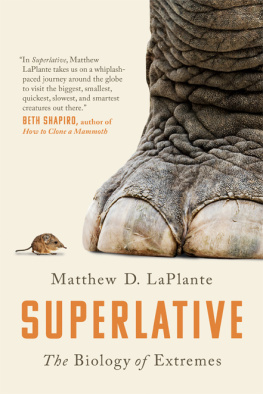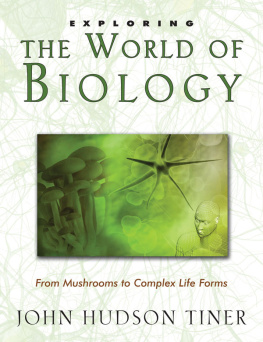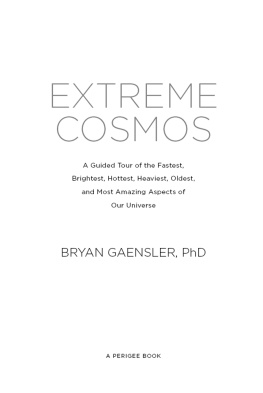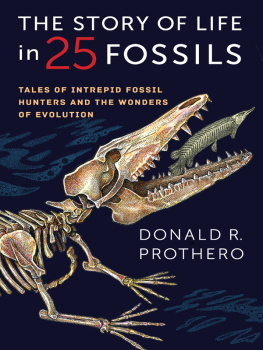Praise for Superlative
In Superlative, Matthew LaPlante takes us on a whiplash-paced journey around the globe to visit the biggest, smallest, quickest, slowest, and smartest creatures out there. In a string of short colorful vignettes, LaPlante explores a medley of superlative creatures one at a time, intertwining science and natural history with spirited storytelling and genuine affection. In the end, we learn that what makes each of these creatures superlative also makes them uniquely valuableto their ecosystems, to science, and also to us.
BETH SHAPIRO, author of How to Clone a Mammoth
Matthew D. LaPlante is a rising star. In his new book, Superlative, he travels to the ends of the Earth to find the smallest, hardiest, most unusual organisms, and the interesting people who study them. As a professor of biology, I was shocked there was still so much I did not know about our brethren at the extremes. Hail evolution.
DAVID A. SINCLAIR, professor of genetics at Harvard Medical School
Superlative is one of the very best books that I have seen in quite a while (and I read a lot). This is one of those rare books that you want to show people while going, Look at what it says here, did you know that? LaPlante writes in an engaging and clear style that perfectly communicates his delight for natures creativity while simultaneously lamenting the tragedy of extinction. As he describes astonishing examples of lifes extremes, he seamlessly combines the sense of wonder that these examples inspire in him with a precise exposition of how this aesthetic knowledge can lead to practical applications, along the way articulating an ironclad case for the value of conservation efforts. Superlative should not only be in the library of any science enthusiast, but it should also be required reading for high school students and beginning college students. Highly recommended.
ON R. PAGN, PhD, professor of biology at West Chester University, and author of Strange Survivors
Superlative displays a key scientific insight: Its the exceptions, the unusual, and the extremes that teach us the most. Matthew LaPlantes exploration of these exceptions is timely, fascinating, and exciting, giving us a chance to see what the future mayquite unexpectedlyoffer us.
MICHAEL FOSSEL, author of The Telomerase Revolution



Although the African bush elephant, L. africana, is the largest land animal, my publisher much preferred the attractive foot of the Asian elephant for the cover. I concur. E. maximus might not be the biggest, but its feet are the prettiest.
Copyright 2019 by Matthew D. LaPlante
Cover photos iStock / coolkengzz and GlobalP; and Shutterstock / puwa2827 and Benny Marty
First trade paperback edition April 2020
All rights reserved. No part of this book may be used or reproduced in any manner whatsoever without written permission except in the case of brief quotations embodied in critical articles or reviews.

BenBella Books, Inc.
10440 N. Central Expressway, Suite 800
Dallas, TX 75231
www.benbellabooks.com
Send feedback to
BenBella is a federally registered trademark.
Second E-Book Edition: April 2020
Library of Congress Cataloging-in-Publication Data for the hardcover edition is available upon request.
9781950665334 (trade paper)
9781948836210 (ebook)
Editing by Leah Wilson
Copyediting by James Fraleigh
Proofreading by Kimberly Broderick and Michael Fedison
Indexing by WordCo Indexing Services
Text design and composition by Katie Hollister
Cover design by Oceana Garceau
Printed by Lake Book Manufacturing
Distributed by Two Rivers Distribution, an Ingram brand
www.tworiversdistribution.com
Special discounts for bulk sales are available.
Please contact .
To Heidi Joy
CONTENTS
S he was a month old and already heavier than me. But she was faster, too, and more energetic. And when Zuri the elephant bolted from her mothers side, kicking up dust and hay, and losing her footing a few times before reaching her tiny trunk toward my camera, I couldnt help but coo with delight.
This was exactly what Id wanted, after all.
I had been covering national security issues for a newspaper in Salt Lake City for several years at the height of the wars in Afghanistan and Iraq. Id made three trips overseas to write about the latter conflict. Id witnessed death, despair, and desolation, and back home I was swimming in news about fraud, abuse, hopelessness, and ineptitude. There was the rash of suicides at a local military facility. There were the service members sickened by working at a former Superfund site. And there was military funeral after military funeral after military funeral.
I was sad and angry. All the time. And I needed to do something about it.
Once in a while, I asked my editor, do you think I could write about something happier?
Something like what? he asked.
Something like baby animals, I replied.
Get the hell out of my office, he said.
I tried again the next day, and the day after. Eventually I won him over. So long as I kept up with my existing workload, he agreed, I could cover the local zoo, too.
A year later I found myself face-to-face with an infant elephant.
Hey there, little one, I said, summoning the same lilting voice I used with my own baby daughter. Welcome to the world.
Zuri paused and posed for a few seconds. She stretched out her big gray ears and tilted her head, then bolted back to her place beside her mothers sagging gray belly. A few moments later, she was back at it, slipping and somersaulting in the mud, and rolling about in the hay. I was smitten.
But then, Ive always been enamored with elephants.
I can still recall my first trip to a zoo. Or rather, I can recall the elephants. One, in particular, was an African bull named Smokey, whose enormity was intensified by the tragic smallness of his concrete pen. I stood in awe of him, feeling at once exultant and terrified. How could anything so big be real? I dreamt of him for years to come. I drew pictures of him in my school notebooks. I wrote stories about him in my journal.
Im certainly not the only child to be obsessed by something superlative. Children are naturally enchanted by extreme things; if you doubt this, just try to wrestle a copy of The Guinness Book of World Records from the hands of an elementary school student. I got my first edition of that book in the second grade. I ordered it from the Warwick Elementary School book club, read through it in a matter of days, and then went back to the beginning and started again. When my daughter was eight, she spent hours leafing through the version of the book that now sits on my desk.
Of course she did. Its endlessly fascinating stuff.
Where is the worlds oldest rainforest? Its all in there, along with a bunch of far-less-natural records, like that held by a guy named Josef Todtling, who in 2015 allowed himself to be lit on fire and dragged 500 meters behind a horse for the dubious honor of saying no one in the known history of humankind had been pulled farther while ablaze.















